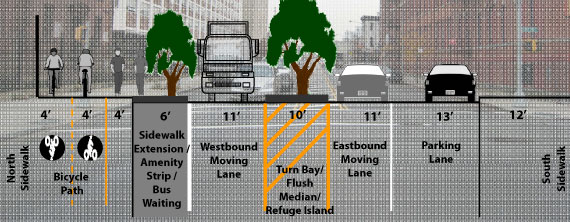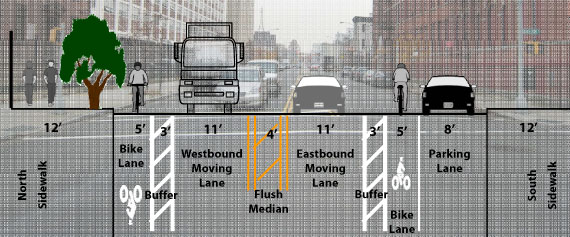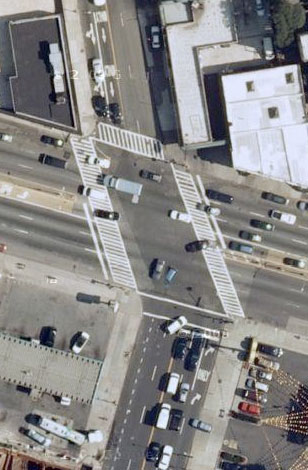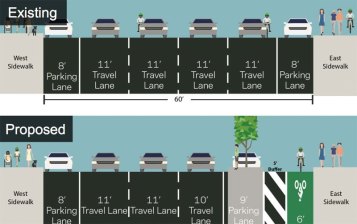Brooklyn CB 2 Committee Approves New Plan for Flushing Avenue Bikeway
 Phase two of the Flushing Avenue project maintains the city’s commitment to a two-way bike path, but Brooklynites will have to wait a few years to get it. Image: NYCDOT
Phase two of the Flushing Avenue project maintains the city’s commitment to a two-way bike path, but Brooklynites will have to wait a few years to get it. Image: NYCDOTLast night, NYCDOT’s Ted Wright presented a revised design for the Flushing Avenue bikeway to the transportation committee of Brooklyn Community Board 2. The new version preserves plans for a fully-protected, two-way bike path while leaving room for two-way bus service and auto traffic. Because the revised design requires more complex construction work than the original, however, Brooklynites will have to wait a few years before that phase of the project gets built. In the meantime, DOT plans to lay down a less-robust interim project, which the committee endorsed unanimously.
The interim project will extend the two-way bike path on Williamsburg Street West — which is protected from traffic by jersey barriers — onto the north side of Flushing, up to Washington Avenue. (To orient yourself, check out this map.) Between Washington and Navy Street, the plan calls for buffered bike lanes on each side of the street. Parking on the north side of the street will be removed.
 Phase one will add buffered bike lanes west of Washington Avenue. Image: NYCDOT
Phase one will add buffered bike lanes west of Washington Avenue. Image: NYCDOTThe original concept for Flushing Avenue called for a two-way, protected bike path all the way to Navy Street, preserving curbside parking while eliminating the eastbound traffic lane. DOT could have built that out as an in-house project this summer, but adjusted its plans after Navy Yard businesses and local residents objected to the new traffic pattern.
The city hasn’t backed away from its commitment to build a safe connection for bicyclists and pedestrians on Flushing, but it will take longer to get there. Phase two of the new plan for Flushing calls for widening the sidewalk on the north side of the street by six feet. The wider sidewalk will then accommodate a two-way bike path and pedestrian space. Since expanding the sidewalk along the entire street entails changes to drainage and grading, phase two will have to proceed through New York’s multi-agency construction bureaucracy. Wright estimated that it would take two to four years to build.
After Wright’s presentation, Alfred Chiodo, a representative of Tish James’s office, said the council member is "very happy with the plan," including the two-phase build-out. Shani Leibovitz, a Navy Yard vice president, also said her tenants were pleased with the plan, which doesn’t alter traffic patterns or bus routes (one westbound bus stop where about 35 people disembark daily, at Ryerson Street, will be removed).
John Eddey, representing Navy Yard tenant Steiner Studios, was still unwilling to fully endorse the second phase of the project, prompting Wright to plead with board members to remember the core goal behind the development of the Brooklyn Waterfront Greenway — to build a continuous route that gives people of all ages a safe path to walk and bike.
"I want to ask you guys to support the greenway as much as possible," he said. "Lets not shoot it down before we get it up and running." The committee voted unanimously in favor of both phases, asking DOT to return with specifics on phase two at a later date.
 The bike lane extension proposed for Vanderbilt Avenue would add some order to a chaotic intersection. Image: Google Maps
The bike lane extension proposed for Vanderbilt Avenue would add some order to a chaotic intersection. Image: Google MapsDOT also presented plans for a new bike route on Vanderbilt Avenue that would link up with the Flushing bike lane. Most importantly, the Vanderbilt proposal extends bike lanes across Atlantic Avenue, a wide, complex, dangerous intersection on a street where more than 1,000 people ride every day. Cyclists riding southbound on Vanderbilt will approach the intersection on a painted curbside lane. On the northbound approach, the bike lane will be placed between traffic heading straight and a right-turn lane. Between Gates Avenue and Flushing, Vanderbilt narrows, and the project calls only for sharrows.
The proposal was crafted in response to a request from the committee, which asked DOT this spring to study gaps in the local bike network identified by CB 2 member Mike Epstein. Despite the fact that the Vanderbilt bike lane would eliminate no parking and leaves traffic patterns basically unchanged, members felt uncomfortable proceeding without informing the Fort Greene Association and the Society for Clinton Hill, neighborhood groups that had received invitations to last night’s meeting but sent no one to attend. (The Fort Greene Association had also endorsed Epstein’s earlier request.)
DOT’s Keith Bray reassured the skittish members that the agency would publicize the project before implementation. Nevertheless, the committee chose not to render a verdict on the proposal.
